One of the things that struck me the most about the Capture Festival was the scale of the event and number of affiliated artists and institutions. This number has grown considerably since the very first Capture Festival in 2013 and continues to increase from year to year. On top of this, it was amazing to see how many galleries and public installations that I see on a regular basis were actually affiliated with the festival, which made the whole experience much more relatable and relevant. To demonstrate this, we decided to plot the festival’s growth on two separate maps of Vancouver. We marked out the various locations with different coloured pins for galleries, public installations, and the Capture office. The physical space taken up by the pins really helps to emphasize and illustrate the growth of the festival. This also shows the growth of the community in the Vancouver area, as more and more individuals and galleries showcase works for the festival.
Category Archives: Capture
Resume line
Capture Photography Festival
Vancouver, Canada
September 2017 – November 2017
Program Intern
- Took photos of billboards (part of Capture’s public art program) for artists and print in Capture 2018 magazine
- Prepared and scheduled posts for Capture’s Instagram and Twitter using Hootsuite
- Organized Vancouver exhibition information for Capture’s blog
- Formatted filename and caption of exhibition submissions
Blog #5 (some thoughts…)
Working in Capture I was surprised how early the team starts preparing for next’s year festival. (Keep in mind that Capture festival starts in April and last through the Summer) Capture starts calling for submission at mid-September every year, which is not far from their last festival. There are a lot of hard work behind each exhibition that the general public would not able to see. If anyone gets to see Capture’s Basecamp (an online agenda for company to organize communication, project, schedule, deadline and so on), he/she will be amazed by how many things they need to handle. Just looking at it can be overwhelming and you can imagine the pressure. From this perspective, Capture team is like a company, where numbers of individuals associated together, utilize their skills and resources, work toward a shared goal. In this sense, Capture is special in the artistic community. If I could take this course again in the future, I hope to experience working in different institution, like gallery, or individual artist.
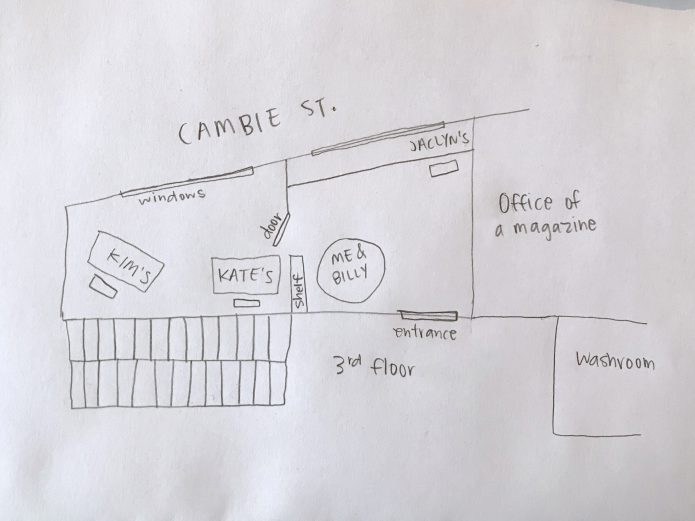
Blog #4
As we are working on the same thing recently, I want to write about the workspace and some conversation with co-workers. The Capture office located two floors above a glasses shop at Cambie and Cordova in Gastown (305 Cambie). The office is about the size of our classroom in BC binning, which is not bad considering there are only three people work there every day (not including me and billy). It is one room divide into two, Kate and Kim work in the inner room and Jaclyn works in the outer room. Billy and I stay with Jaclyn, but usually the door that part the two room is open which make the space one big room. Besides human, there are three cute dogs stay in the office with us. Kim and Kate work full time as executive director and program manager while Jaclyn works part-time as festival manager. Since the team is relatively small, Kim is usually busy and our task is given by Kate and Jaclyn for most of the time. There is no clear hierarchy in the office, everyone just busy on the job that they are responsible for.
Because of the partnership, I go to Gastown more often than in the past two years. I feel that the area radiant from East Hasting via Main street is the art scene of the city, where a lot of creative industries set their location there and they depends mostly on mental labor. It is true that “communication is productive within the contemporary working environment” (Gielen). A lot of work done by the Capture team is contacting and talking to artists, curator instead of actually producing.
Among the Kim Kate and Jaclyn, we interact with Jaclyn the most as we stay in the room together. I was glad that I got the opportunity to take to someone in the industry(?). Through conversation, I know that Jaclyn spent her undergraduate at UBC majoring art history and minoring English and she also studied in Scotland after undergraduate. I ask about her career path and she said that she doesn’t have a clear career path. Instead, she said it was an accumulation of many small positions make her where she is today. She initially worked at a magazine, which its office is just next to Capture’s office. Beside the part-time job at Capture, she also works as a freelancer on editing. Jaclyn is very nice that she informs us about the funding of the BC art council, which could be very helpful if artists decide to stay in BC (which could be us). She also told a story of their former intern, who is 27-year-old, tired of short-term contract and confused about the future. Although I have not started working in the real world and develop my career, I can relate to the story and thought it could be me. I still don’t know how to answer the question “what is your plan after graduate?”. I enjoy listening and learning from other people’s story but at the same time everyone is different and there are millions of ways to get to where you want, especially in creative industry. I can foresee, no matter what, it will be hard at the beginning.

Blog #3
Recently, we work in the Capture office as usual. However, after weeks of working on the social media, we finally get to work on something new. This week we get our hands on the Capture 2018 exhibition submissions. Our task is to format the file names and caption of the images submitted by curator and artist. The goal is to format them according to instructions provided so that the files/information would be easy to search for. Billy and I went through 80 submissions in total. It was fascinating to see the diversity of artists, mediums, and topics. I am excited to go to the exhibitions next year.
Besides that, we made a list of artist/exhibition that doesn’t have enough information (like medium, dimensions of the work) so that Jaclyn can contact them for more information. Making the list was not mandatory, but since it was a relatively easy task, I feel that I should complete the task as perfectly as possible and it is more convenience for whoever takes over or follow along the submission program. I learned the way to properly organized files and the formal format of captions, which will be very helpful later when I need to organize/archive my own works.
So far, the task given to us was not too challenging. I feel that it is important to communicate with our supervisor during the process if we encounter any problem. After completing the task, to think about the process, reflect what I learned from it is also very helpful for improvement and knowledge/experience accumulation, even if the task is easy.
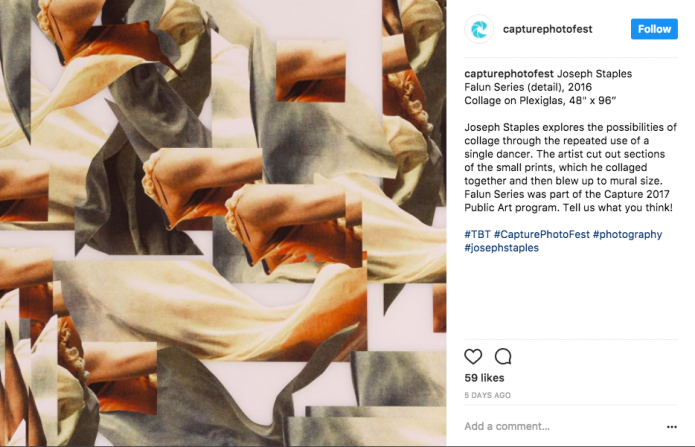
Blog #2
For the past two weeks (Oct 12, 19), Billy and I were doing a research on Capture artist/gallery upcoming exhibition and preparing post for Capture’s social media.
Capture is working on a website that provides updated exhibition information about artist and gallery that participated in the festival in the past. Our job is to collect the exhibition information. Kate showed us a website (http://backup.parisphoto.com/agenda?t=last-days&grid=1) and explain what they expect the Capture one looks like. So Billy and I basically went through all the Capture magazine and did the research. There are more than 40 galleries in the Great Vancouver, which is more than what I know or expected. However, through researching their upcoming exhibition, I found that there are only a few galleries focus on lens-based art and there are not many exhibitions on photography. Through this I realized the importance of the Capture, as an annual photography festival that devoted to spark and expand public dialogue on photography as a form of art.
The other thing we were working on was preparing some #tbt posts for Capture’s Instagram and Twitter. These posts aim to get people excited about the upcoming Capture Festival. First, we had to select few images from the 2017 photo documentation, then we need to write the captions for the posts. We did some research on other public accounts, such as their writing and choice of image. We also looked through the previous posts by Capture in order to avoid repetition. Billy and I struggled a bit with the writing since it is the first time for both of us to write for a public account. After finishing the draft, we showed it to Kate, Jaclyn, and Kim. Kim suggested that we should choose images that have vibrant color in order to attract people and Jaclyn proofread our draft. After a few revises, we post our draft on HootSuite, which is a social media management platform that sends posts automatically at the time you set. Through arranging posts and getting feedback from our supervisor, I learn more about social media strategy. I think it is useful because, nowadays, probably any industry has to promote themselves through an online platform.
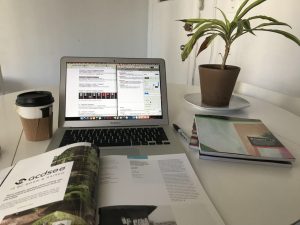
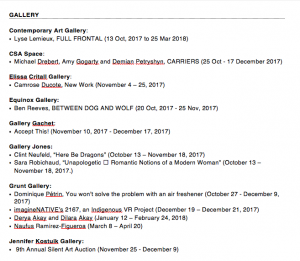
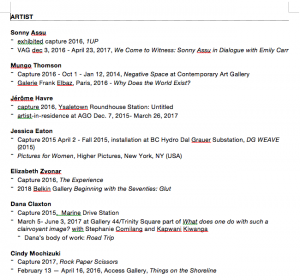
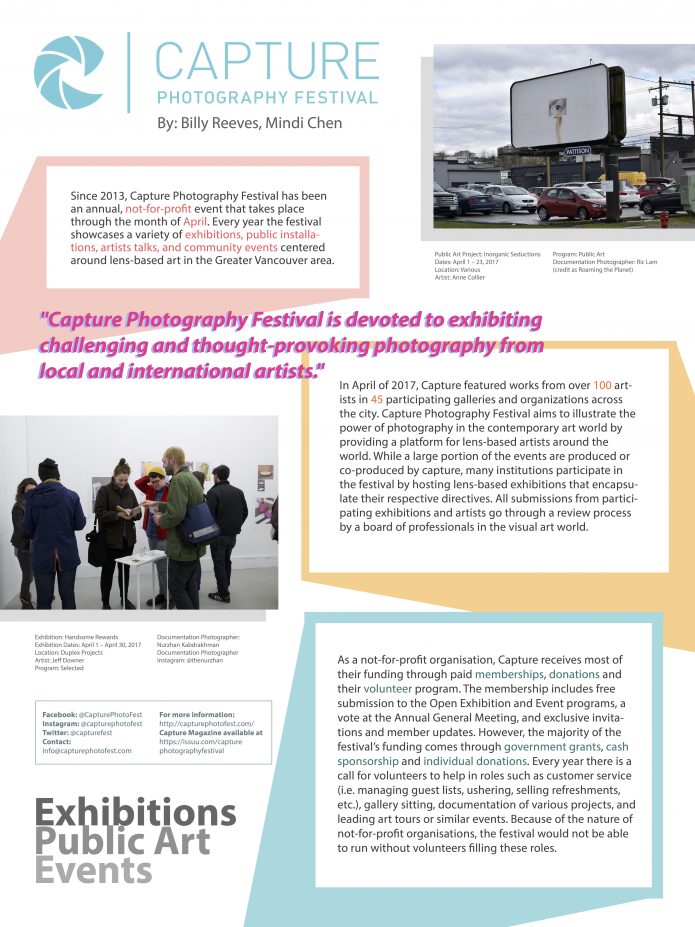
Poster
“Capture Photography Festival is devoted to exhibiting challenging and thought-provoking photography from local and international artists.“
Since 2013, Capture Photography Festival has been an annual, not-for-profit event that takes place through the month of April. Capture mainly works on three programs–exhibition program, public art program, and event program. Capture receives most of their funding through paid memberships, donations, sponsorship, advertisement, and government grants. Besides the Capture team, there is a group of volunteers who help running the events. Capture Photography Festival aims to illustrate the power of photography in the contemporary art world by providing a platform for lens-based artists around the world.
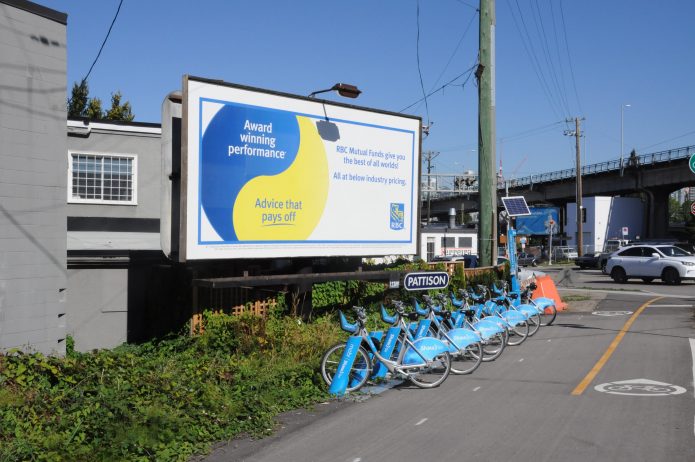
Blog #1
In the past two week, I was working on two tasks. One was to take photographs for billboards where Capture will put on lens-based artwork in the near future, the other was to contact Capture exhibiting artists for an equipment research.
Capture Photo Festival publishes a magazine annually reporting their works throughout the year, my task was to take photos for the billboards where Capture put works from both local and international artist on it, and this was completed by me individually. Hopefully, Capture will choose my photos and publish on the magazine. Besides the photographs for the billboard, I also take some informal photos of the surrounding to share with the artists, just to give them an idea of the environment where their work would be put on, since some of them are international artists and they are not able to come to Vancouver. Capture not only works on an exhibition program, they also have public art program and events program that aim to spark public dialogue about photography. The billboard project is part of their public art program. This year, they plan to put artworks on 6 billboard, two 2-sided boards and two single-sided boards along the Arbutus Greenway between Fir and Burrard Street and 5th and 6th Avenue. During that week (Sep 28th), I don’t need to report to the office. Taking the photographs only takes about an hour, I used the rest of the time to edit the photographs at home to fulfill the required learning-working hours. A problem I encountered during the shooting was that there was actually more than 6 billboards on the site. To avoid omission, I take photos of all the billboard in that part of the Arbutus Greenway. Before going out for the photographs, Kate (our supervisor) shared a few examples of billboard images with me and I did some research on billboard images additionally. Luckily it was sunny on the shooting day and I enjoyed the time.
The other thing I worked on in the past week (Oct 5th) was contacting Capture exhibiting artists for an equipment research. Fuji Film reached Capture about potential sponsorship on artists who use Fuji equipment. Billy and I were given a list of contact information and we need to send them emails asking what equipment they use. There were around 50 artists we need to contact, so we divided the list into two part, each of us will do half of the list. Before sending the email, we double checked the list and discussed with Kim, Kate, and Jaclyn on how we should phrase the email to avoid any mistake. One thing I noticed is that as part of the organization, we need to be very rigorous when communicating with our exhibiting artist in order to keep a good and productive relationship with them.
The tasks I completed so far was not too challenging, but it allows me to apply what I learn in class to work and allows me to observe and experience how such not-for-porfit organization works.
Project Outline
Capture festival present exhibitions throughout the province of British Columbia annually in the summer time, which means I might not able to help set up exhibitions as I expected in the very beginning. However, the team is currently receiving and reviewing submission of exhibitions, Billy and I were will be reviewing part of the submissions together.
Besides the annual photography exhibition in the Summer, Capture festival is also working on a public art program. The program aims to introduce both local and international artist, present their works and provoke thoughts and conversation. Currently, my task is to photograph the billboards along the Arbutus Greenway. Good quality photographs are needed for the magazine that Capture published once a year showcasing their work. I also have to take photos of the surrounding to sent to the artist, so that they can be familiar with the environment in which their works will be displayed. I am happy to utilize skills I learned in photography class to complete the tasks.
The first meeting with Kate, the program manager of Capture, took place in their office in around gas town. We discussed our interests and what skills we hope to gain in the partnership. Kate showed us a range of potential works and we figured out what specific task we will be working on based on our interest and strength. About half of the works will need Billy and I work together, another half will be completed individually. I am happy that I am able to choose what to work on individually, at the same time, learn from working as a team.
We agreed that Billy and I will report to Kate every Thursday at around 9:40am and work in the office for around 5 hours. However, working hours and location could be flexible and it really depends on the tasks we are working on at that time. For instance, I was asked to take photos for Capture’s magazine this week. In this case, I don’t need to go to the office and I will edit the photographs at home.
As we work in the office with Kate for most of the time, we are able to communicate directly. When we are not in the office, communication will take place via email or phone. It is the first time for Capture festival to have UBC student/intern to work with and learn from them, so both of us are still figuring out what’s the best way for us to work together. Communication and getting feedback is particularly important.
Although tasks assigned so far didn’t come with a specific deadline, we are expected to complete it as soon as possible. Generally, I am very excited to work with the Capture Festival and curious about what changes the partnership can bring to me.